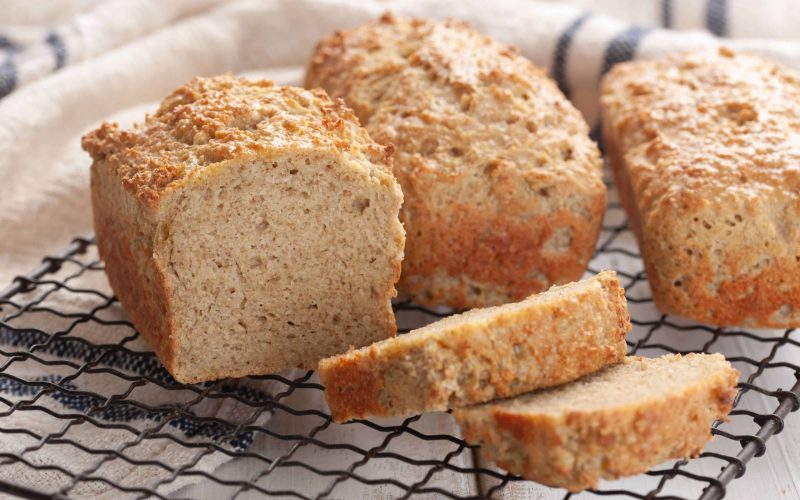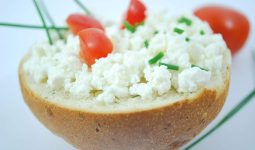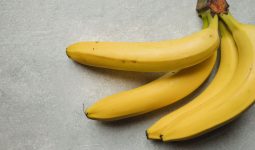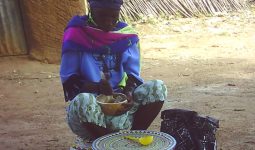Gluten-free bread, just as the name implies, is bread that is free of gluten. In this article, we will explore the ingredients for gluten-free bread.
Before we go further, examining what gluten is and why some people opt for gluten-free bread is expedient.
What is Gluten?
Gluten is a protein found naturally in cereal grains like wheat, rye, barley, triticale, and a crossbreed of these grains.
Gluten is the component that gives grain products shape, strength, and texture. It also acts as a binder and gives dough elasticity.
This usually occurs when flour mixes with water. Here, the gluten protein forms a sticky web with a glue-like consistency.
The name gluten is derived from this glue-like property of wet dough. Without gluten, the dough would rip easily.
So, gluten-free bread is made without wheat or cereal containing gluten, i.e., replacing gluten flour with one without gluten.
More than gluten-free flour is required to make ideal gluten-free bread. A healthy substitute for gluten can give your bread the elasticity and consistency it deserves.
As we examine ingredients for gluten-free bread, we will also explore healthy substitutes for gluten.
Before we examine that, let’s briefly explain why some people opt for gluten-free bread.
Reasons People Go for Gluten Free Bread
There are generally 3 reasons people go for gluten-free bread.
- The first reason to be examined here is a gluten allergy. Some people diagnosed with celiac disease are allergic to gluten products as it affects them strongly. More so, the disease cannot be cured but is only managed by consuming gluten-free food, hence why they opt for gluten-free bread.
- Another reason is Intolerance. This factor here is a less severe reaction to gluten. But then, for some people, this discomfort is enough to make them avoid gluten.
- Some people go gluten-free because, for them, it’s a lifestyle. It all boils down to choice here.
Ingredients for Gluten Free Bread
Now that we know why some people choose gluten-free bread, let’s examine the ingredients needed to make it.
1. Flour
One of the most obvious and biggest ingredients for gluten free bread is flour. This is because flour forms a bread’s volume and eventual structure.
Flour also plays an important role in bread’s texture and taste quality. The good news is that flours labeled gluten-free are already on the market.
Examples of gluten free flour that can be used to make bread are rice flour, potato flour, oat flour, corn flour, millet, sorghum flour, brown rice flour, cassava (tapioca) flour, quinoa flour, amaranth flour, and buckwheat.
The ideal gluten-free bread uses a mixture of different gluten-free flours. There is not one single type of flour that does it all.
Instead, a blend of at least three or four flours is necessary to create a bread texture similar to wheat bread, i.e., one that doesn’t crumble and is not rock solid.
Today, flour brands sell a ready-mixed blend of gluten-free flours, proven to work well when baking gluten-free bread.
Nevertheless, it is tactful to note this secret flour formula for a good gluten flour blend. Your light flour should form at least 50% of your flour, such as yellow corn flour, gluten-free oat flour, brown rice flour, and white rice flour.
25% of the flour used should be protein and fiber-rich, as this would create the bread’s structure.
Examples of such flour include chickpea flour (also known as gram flour), soy flour, potato flour, teff flour, or a blend of them.
The other 25% of the flour should be starchy, as these will help to bind the dough together.
Examples are corn flour (commonly used for thickening sauces and sometimes called cornstarch), arrowroot, tapioca, or potato starch.
Note that potato flour, made from whole potato, differs from potato starch. In a nutshell, a sample blend is grain flours (like rice or sorghum) incorporated with starch flours (such as corn or tapioca), bean flours (like garfava or soy), and nut meals (like almond or pecan).
2. Warm Water
This is also a very important ingredient here. The warm water helps activate (proof) the yeast. Please avoid using HOT water here. Hot water can kill the yeast, which stops it from activating and rising. Emphasis is on warm water.
3. Yeast
Yeast is also one of the ingredients for gluten free bread. It is a natural raising agent. The amount of yeast to be used depends on your measurement.
You may think bread that rises super-fast is a good option, but it is false because it falls in the oven.
Use fresh yeast to avoid yeast issues. Store yeast in an airtight container or close it thoroughly and put it in the fridge to keep it fresh.
You can activate the yeast with warm water. Raw apple cider vinegar also activates the yeast. Besides, the vinegar reduces bread spoilage and improves the texture and crumb of the bread.
4. Binding Agents
A binding agent is also among the key ingredients for gluten free bread. It gives dough the elasticity and strength that it needs to rise.
The quantity of a binding agent that you need will depend on the recipe and the binding agent you decide to utilize.
The most common binding agent is the egg. It acts as a binder to hold the bread together. It also helps create a fine, uniform texture and improves cohesion and springiness.
Eggs add liquid and fat. You can replace the egg if you are on a vegan diet.
However, know that gluten-free flour needs a binder to help gel the ingredients together, so the egg replacement you decide to use should do a good job. A popular replacement here is psyllium husk.
Psyllium husk is a plant-based powder that helps maintain moisture and prevents the bread from crumbling.
The psyllium husk should be hydrated with whatever liquid you use before being added to the dough. It will turn the liquid into a gel.
Others are xanthan gum, guar gum, Flax, and chia seeds. You can also use aquafaba (chickpea brine) and agar (vegetarian gelatin).
Whatever binding agent you decide to go for boils down to you. You can also experiment with a mixture of plant-based binding agents to find the one that works for you.
Nevertheless, always know that a binding agent is a key to getting gluten free bread to work just fine.
5. Salt
Salt is one of the oldest flavors in the world. When it comes to gluten-free bread, salt is no exception. It adds flavor to the bread.
Okay, let me add this here: Salt also slows down the action of the yeast so that it rises slowly. More so, salt strengthens the dough’s gluten structure, not allowing the trapped carbon dioxide bubbles to expand too quickly, which helps produce bread with a fine texture.
6. Sugar
Sugar is also among the ingredients for gluten free bread. It enhances the bread’s flavor and gives the bread’s crust a golden color.
Besides sweetening the bread, sugar improves crumb texture and moistness and reduces stalling.
If you want to avoid using sugar, you can easily replace it with honey or agave nectar. They work fine, too.
7. Fats and Oils
Fats and oils improve bread’s softness, shelf life, and volume. They can be added in liquid form, such as melted butter.
If you want vegan, gluten-free bread, you must use plant-based oil. Olive oil works great here, too.
Better yet, you could opt for vegetable or even melted coconut oil. Fats and oils are also important ingredients for gluten-free bread.
8. Milk/Water
One of the most important ingredients in gluten-free bread is liquid. This is because gluten-free flour often needs more liquid than regular wheat flour.
You can use milk or water here as the liquid. Using milk makes the bread richer. If you want to go vegan, Non-dairy milk works fine, too.
If you want to avoid milk completely, then, by all means, go for water. You would still get a good result.
9. Additives
Our list of ingredients for gluten-free bread also includes additives. These additives include raising agents, emulsifiers, preservatives, flavorings, and aromas.
How to Make Gluten Free Bread
Now that we have examined the ingredients for gluten-free bread, let’s take a quick look at how to make it.
Step 1: Prep The Ingredients
The first step in preparing gluten-free bread is to prepare your ingredients and materials.
The abovementioned ingredients were flour, warm water, yeast, binding agent, salt, sugar, fat and oils, milk/water, and additives. The measurement of the recipe is down to you.
Step 2: Make the Dough.
Making the dough takes the bulk of the work and will determine your gluten-free bread’s eventual outcome. First, proof your yeast.
To proof the yeast, gently stir the yeast and sugar ( honey for vegans) into a cup of warm water (the water should be between 105 and 115 F).
Let the mixture sit for five minutes to become bubbly/foamy. This indicates that the yeast is doing its thing.
If you are vegan, arrange all your liquid ingredients in a separate bowl, for example, the egg or its substitutes.
Other liquids are milk or its vegan substitute. Melted fat (butter) or its vegan substitutes (e.g., olive oil)
Measure and mix the flours. Whether you choose a ready-made gluten-free flour blend or make your own, ensure that you use a scale when in doubt.
Add the flour’s other dry ingredients (e.g., salt and any dry additives or binding agents). You can mix the wet ingredients (i.e., the yeast/water mixture and other liquid ingredients) into the dry flour to make a sticky dough. Mix it thoroughly with a hand or stand mixer for at least 4 -5 minutes with a mixer.
In summary, the dough process uses three bowls. The ingredients in each bowl should be mixed separately before combining the wet and dry ingredients.
The first bowl contains warm water, sugar, and yeast, while the second contains the flour and other dry ingredients. The eggs, oil, and remaining liquid ingredients enter the third bowl.
Step 3: Greasing
Now that you have mixed your dough. Grease your loaf pan with a solid fat (e.g., coconut oil or butter). Use white rice flour to dust the bottom and sides of the pan lightly.
The grease would make the bread glide out of the pan easily and neatly. Scoop your dough into the bowl and cover the bowl with plastic wrap.
Set it in a warm location for 40-60 minutes to give the dough time to rise. The dough is ready when it smells yeasty and looks puffy.
Step 4: Bake the Bread
Now, we have reached the peak. Bake the bread! Preheat the oven to 400°F before placing the dough in the oven. Bake for 50-60 minutes at 375°F until golden and well risen.
Insert a wooden pick in the center to determine if it’s done. If the wooden pick comes out clean, then it is ready.
For cooling, take the pan out of the oven, remove the bread from the pan, and allow it to sit on a cooling rack for 10-15 minutes before slicing and serving. Your gluten free bread is ready!
Conclusion
As this article has examined, gluten-free bread is free from gluten. It also explored some reasons why people opt for gluten-free bread.
Some people do this because they are trying to manage celiac disease, and others to manage other types of medical conditions associated with gluten. And yet, for some, a gluten-free diet is a matter of choice and trend.
This article explores the ingredients for gluten-free bread: flour, warm water, yeast, binding agent, salt, sugar, fat and oils, milk/water, and additives.
Among these ingredients are substitutes for gluten that can give the gluten-free bread shape, strength, and texture.








